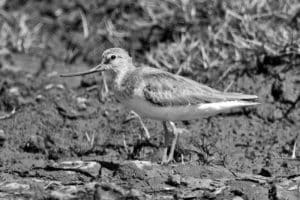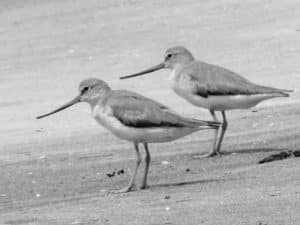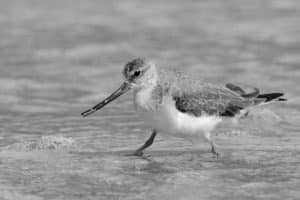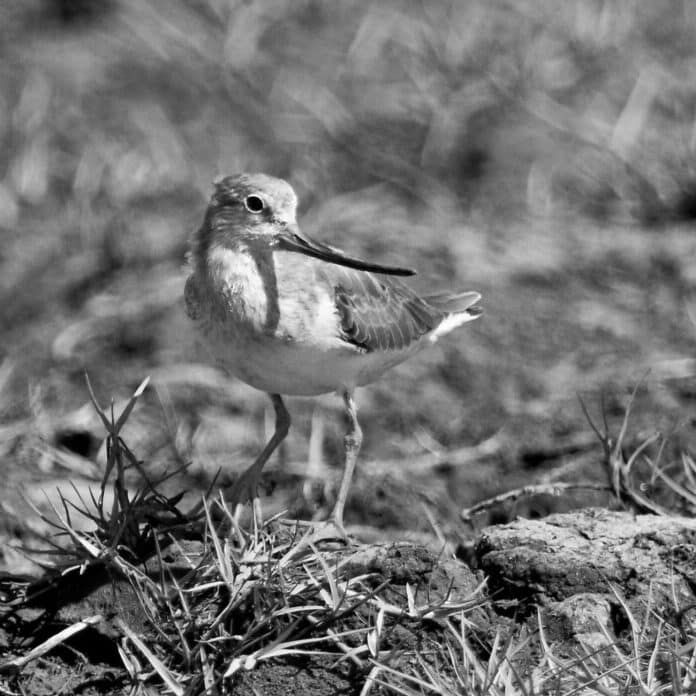Introduction to the Terek Sandpiper
The Terek Sandpiper in Tanzania (Xenus cinereus) is a small wading bird that breeds in the wetlands of northern Eurasia and migrates to coastal regions in Africa, Southeast Asia, and Australia during the winter months. They are named after the Terek River in Russia, where they were first discovered. Terek Sandpipers are relatively small, measuring around 20 cm in length, with a distinctive long, thin bill and grey-brown plumage that helps them blend in with their sandy surroundings.
The habitat of the Terek Sandpiper in Tanzania

In Tanzania, Terek Sandpipers are found along the coast, particularly in the wetlands and estuaries of the Rufiji River Delta, Saadani National Park, and the Zanzibar archipelago. They prefer sandy or muddy shorelines with plenty of vegetation and shallow water for feeding. During the breeding season, they nest in the tundra regions of northern Eurasia, but migrate south to warmer climates during the winter months.
The migration patterns of the Terek Sandpiper
Terek Sandpipers are migratory birds, and their movements are largely dictated by changes in weather and food availability. During the breeding season, they can be found in the wetlands and grassy tundra regions of northern Eurasia, where they build their nests and raise their young. As the weather turns colder in the fall, the Terek Sandpiper begins its long journey south. They travel along the eastern coast of Africa, stopping in Tanzania and other coastal regions to feed and rest before continuing on to their wintering grounds in Southeast Asia and Australia.
The significance of the Terek Sandpiper to the coastal ecosystem in Tanzania
The Terek Sandpiper plays an important role in the coastal ecosystem of Tanzania. As a wading bird, they feed on small invertebrates like insects, crustaceans, and worms, which helps to control their populations and maintain a healthy balance in the ecosystem. Terek Sandpipers are also an important food source for larger predators like fish and birds of prey. Their presence in the wetlands and estuaries of Tanzania is an indicator of the health of these important ecosystems.
Conservation efforts for the Terek Sandpiper in Tanzania

Like many migratory bird species, the Terek Sandpiper is facing a number of threats to its survival, including habitat loss, climate change, and hunting. Conservation efforts are underway in Tanzania and other countries to protect the wetlands and estuaries where Terek Sandpipers live, and to reduce the impact of human activities on their habitats. Birdwatchers and nature enthusiasts can support these efforts by visiting the areas where Terek Sandpipers live, supporting local conservation groups, and spreading awareness about the importance of protecting these vulnerable creatures.
Best times and locations for birdwatching the Terek Sandpiper in Tanzania
If you’re hoping to catch a glimpse of the Terek Sandpiper in Tanzania, there are a few key locations and times to keep in mind. The Rufiji River Delta and Saadani National Park are both excellent places to see Terek Sandpipers, particularly during the winter months when they are more likely to be found along the coast. The best time of day for birdwatching is typically early morning or late afternoon, when the birds are most active and the light is best for photography.
Photography tips for capturing the Terek Sandpiper in its natural habitat
Capturing a clear and beautiful photo of the Terek Sandpiper can be challenging, but with a few tips and tricks, you can improve your chances of success. First, be patient and observe the birds’ behavior, so you can anticipate their movements and position yourself accordingly. Second, use a fast shutter speed to freeze their motion and capture sharp details. Finally, try to get down to eye level with the birds to create a more intimate and engaging photo.
Other bird species to look out for while birdwatching the Terek Sandpiper in Tanzania
While the Terek Sandpiper is the star of the show when it comes to birdwatching in Tanzania, there are plenty of other interesting and beautiful species to look out for as well. Some of the most common bird species you might encounter include flamingos, egrets, herons, and storks. Keep your eyes and ears open for their distinctive calls and behaviors, and you’re sure to have an unforgettable birdwatching experience.
Recommended tours and guides for birdwatching the Terek Sandpiper in Tanzania
If you’re planning a birdwatching trip to Tanzania, consider hiring a local guide or joining a tour to maximize your chances of seeing the Terek Sandpiper and other interesting species. There are many reputable tour companies and guides available, with a range of options to suit different budgets and interests. Some of the most popular tours include visits to Saadani National Park, the Rufiji River Delta, and the Zanzibar archipelago.
Conclusion: Appreciating the beauty and importance of the Terek Sandpiper in Tanzania

The Terek Sandpiper is a rare and beautiful creature that plays an important role in the coastal ecosystem of Tanzania. By learning more about these fascinating birds, supporting conservation efforts, and exploring their habitats, we can appreciate their beauty and importance and help to ensure their survival for generations to come. Whether you’re a seasoned birdwatcher or a nature enthusiast, a visit to Tanzania to see the Terek Sandpiper is an experience you won’t soon forget.


































